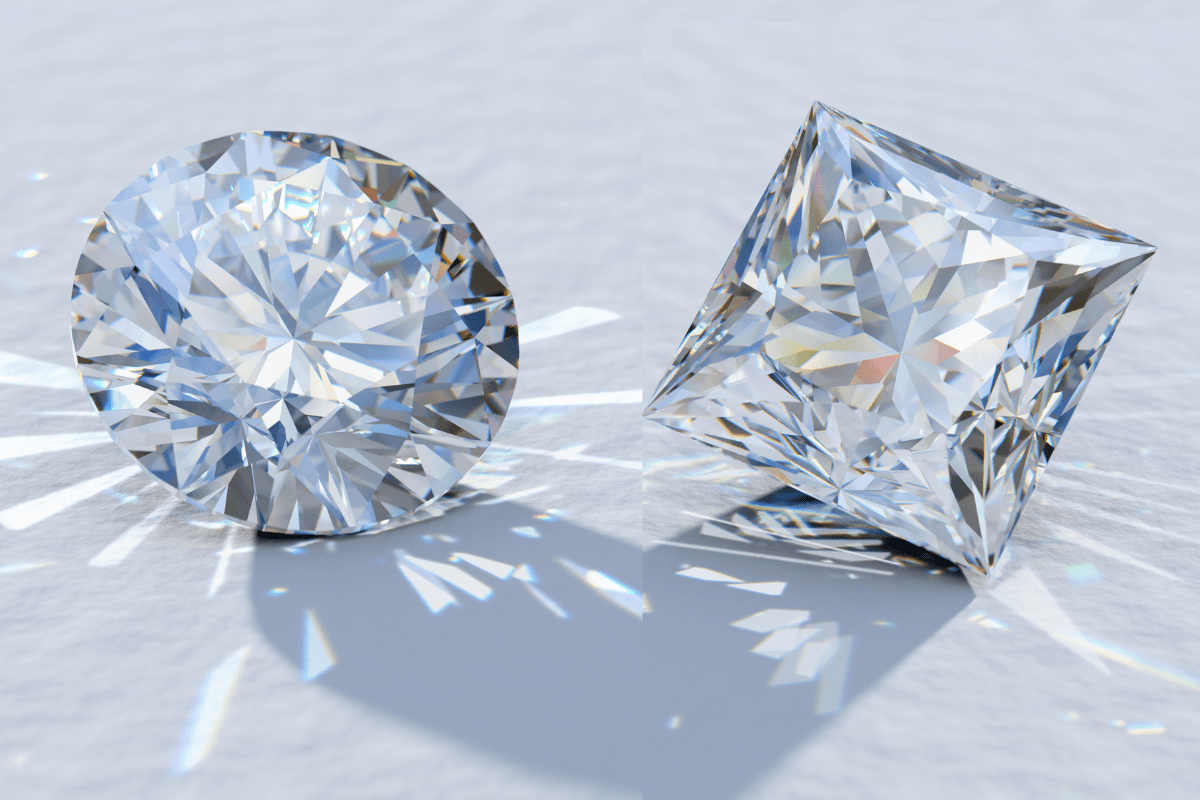
Table of Contents
Choosing an engagement ring is no easy feat. This is a piece of jewelry that will last a lifetime and be worn every day. So, it has to be something that you absolutely love!
If you have decided to go with a diamond engagement ring, that’s one big decision ticked off. But what shape are you going to choose? While there are over 10 well-known cuts, there are two that are the most popular.
The round cut and the princess cut.
From these two, the round cut heads the race as the most popular diamond shape. Over 70% of the world’s GIA-certified diamonds are fashioned into this shape while the square-shaped princess cut accounts for only about 5%.
Percentages aside, deciding between the round and the princess cuts can be difficult because they both have pros and cons. But to help you decide, we’ve focused on the most important factors that you need to consider when making your choice.
Ready? Let’s get right into it!
The Round Cut Vs. The Princess Cut
Let’s start by taking a quick look into what these two cuts are, their origins, history, and characteristics.
The Round Brilliant Cut Diamond
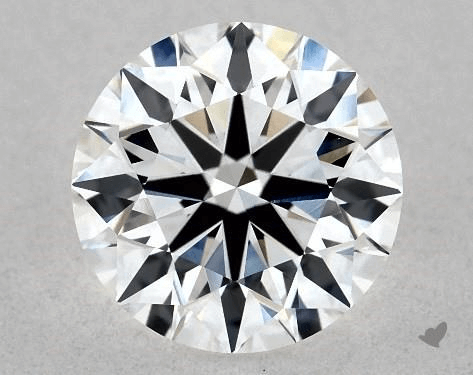
The round cut, as we’ve already gone over, is the most popular among diamond engagement rings. It has been around since the tradition of giving diamond rings as an engagement gift began and is considered the classic engagement ring cut.
The round cut exhibits the most brilliant sparkle and fire of all the diamond cuts. This specific quality is due to the round shape that allows maximum light to pass through and be reflected on the surface. The faceting pattern of the cut also contributes to this sparkle. No other cut is able to equal, let alone rival, the brilliance of the round cut.
A round cut has the advantage of producing symmetry from all angles especially when the faceting is excellently executed. This symmetry is what gives the round cut greater light performance that angular cuts just cannot compete with.
The Princess Cut Diamond
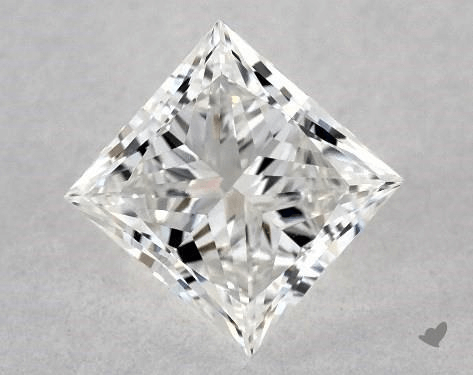
The princess cut is more recent and was designed with the aim of creating a square cut that could exhibit brilliance similar to the round cut. It is the second most popular diamond engagement ring shape, and has a modern and trendy appearance.
Among all the fancy shapes for diamonds (non-round cuts), the princess cut has the most potential to show equal brilliance and sparkle of a round cut due to its faceting pattern. It combines the brilliance of the round cut with the modern, trendy square shape.
This edgier cut is typically square in shape but can also appear slightly rectangular. In gemology, the princess cut is termed as the square modified brilliant, owing to its square outline shape and brilliant facet arrangement.
Round Cut vs. Princess Cut: Brilliance and Sparkle
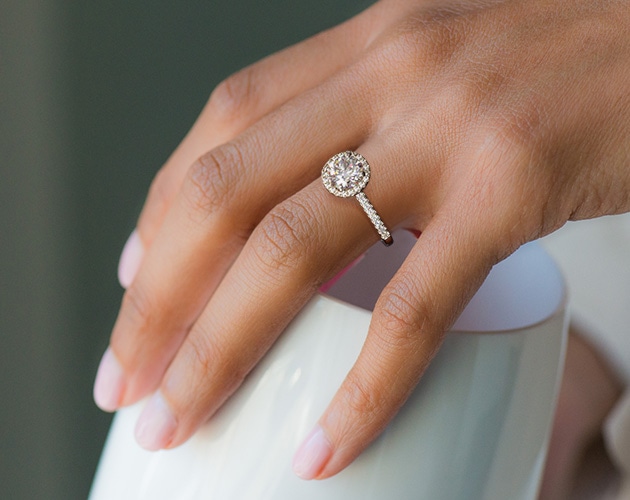
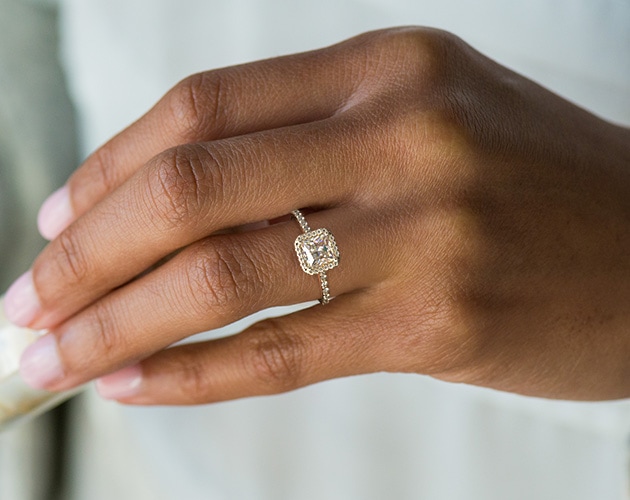
The main similarity between these two cuts lies in the fact they are both designed to maximize brilliance and fire. While the round cut contains 57 or 58 facets, the princess cut can have either 57 or 76.
The winner of this round? The round cut.
While the princess cut is the most brilliant of all the fancy shapes, it just doesn’t have the ability to reflect light like a round diamond. A high-quality round diamond, that has been expertly cut, can reflect more than 90% of the light that enters it. It just has that extra brilliance that no other cut has.
Round Cut Vs. Princess Cut: Price and Value
Diamonds don’t come cheap and cut is a factor to consider. Unfortunately, the most popular cut also happens to be the most expensive cut of all.
Why is this, you ask?
It boils down to a couple of factors. The demand for round diamonds and the yield from the diamond rough.
The amount of diamond rough wastage that occurs when cutting a round shape is much higher than when cutting a princess shape.
Consider that a rough diamond is naturally cubic in shape. In order to cut a round diamond, only about 40% of the diamond rough is used! Couple this with the fact that most people want round diamonds, and you can see why the round cut commands premium prices.
On the other hand a princess cut uses about 80 to 90 percent of the rough diamond, with only about 20% wasted! Two princess cut diamonds can be shaped from one diamond rough, resulting in a lot less wastage of the rough diamond.
The two examples below show a round diamond and a princess diamond that have very similar features. However, the round diamond is significantly more expensive than the princess cut by a very significant amount.
1.01 Carat Princess Cut Diamond
If budget is a priority, then opting for a princess cut isn’t a bad way to go. The princess cut is consistently cheaper than the round.
Round Cut vs. Princess Cut: Clarity
Princess cuts happen to be more forgiving of inclusions and impurities contained within the stone.
Because of its angular shape and the faceting arrangement, princess cuts can hide a flaw better than a round cut.
What does this mean for you, the shopper?
You don’t have to choose the highest clarity grades for your stone.
If you know anything about diamond clarity, you’ll know that the higher the clarity level, the higher the price of the diamond. All things being equal, a flawless stone always commands a higher price.
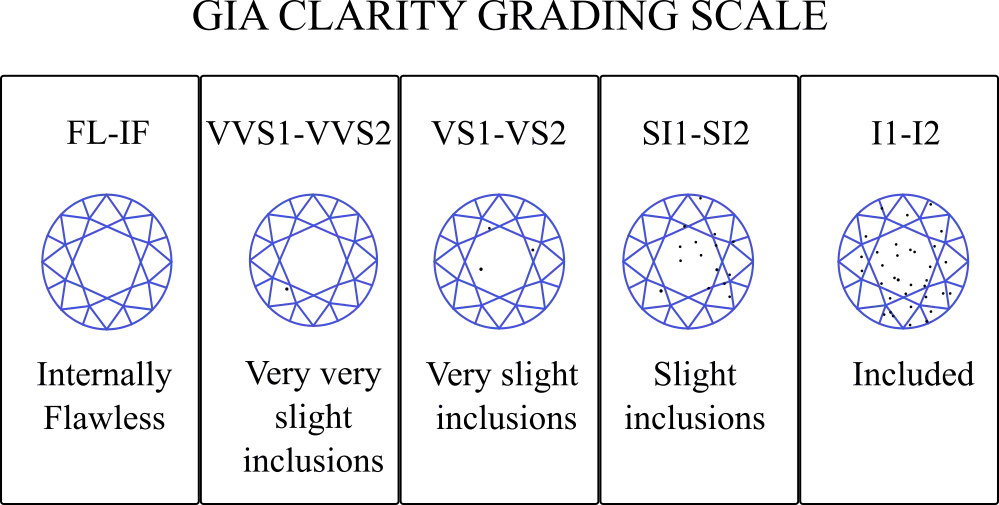
When choosing your princess cut, you can opt for a VS1 grade diamond for a larger stone and still get an excellent rating. For smaller stones, you can opt for VS2 with excellent eye quality.
For round diamonds, it is recommended that you go as low as VS2 for small stones and VVS2 for larger carat sizes in order to still have an excellent clarity rating and eye-cleanliness.
Round Cut vs. Princess Cut: Which is Bigger?
This is a tricky question.
If we were to measure a 1-carat princess cut and a 1-carat round cut, we would find that the round cut has up to 10% more surface area than its square counterpart. So mathematically, the round cut is winning in this area.
However, the diagonal length of a princess cut measures longer than the diameter of a round diamond. This means that when you look at the two stones, you may see the princess cut as bigger.
This optical illusion is why many people say that the princess cut is much bigger than a round cut.
From a logical standpoint, if you were to spend the same amount on a princess cut as you would on a round diamond, you would be able to buy bigger diamond due to the difference in price.
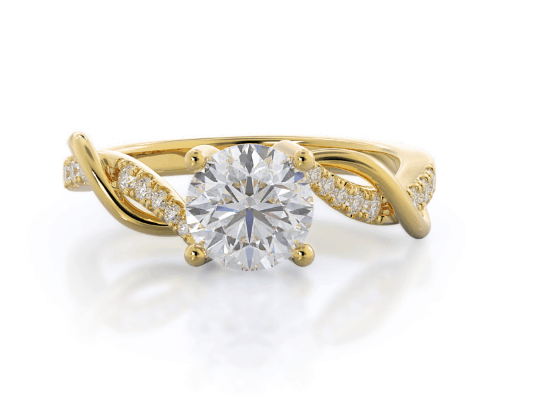
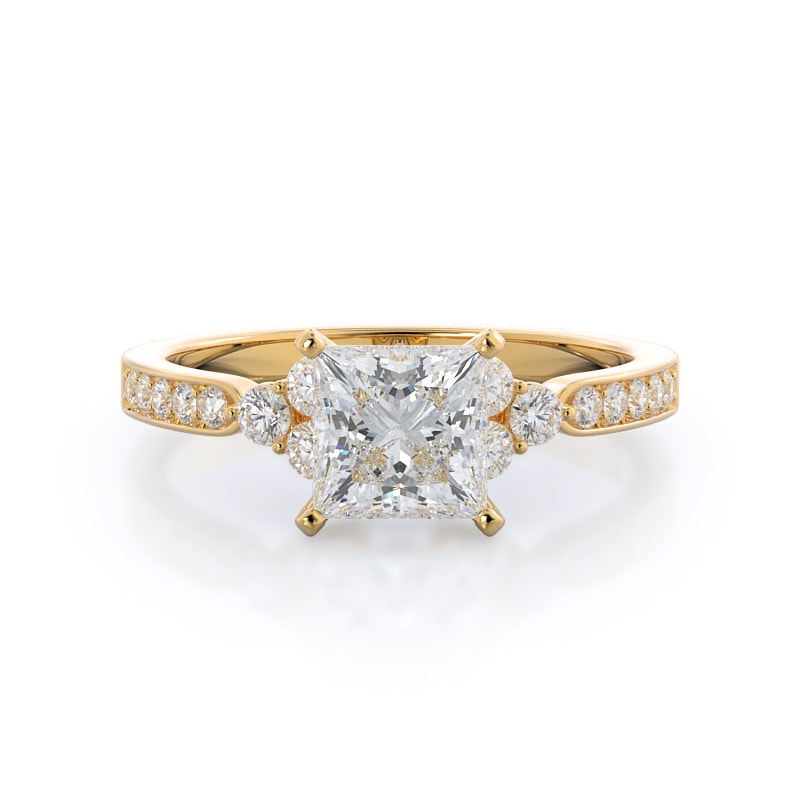
If you would like to see which looks bigger and better on your finger, you can make use of With Clarity’s Home Preview Service, which allows you to customize up to 2 engagement rings and then have replicas posted to you to try out for a few days.
Note that this service is completely free of charge with no commitment to buy. This would give you the opportunity to compare the round and princess cuts and decide which of the two you prefer. For more information read our complete review on With Clarity’s Home Preview Service here.
Round Cut vs. Princess Cut: Durability
Since round cuts have no angles, the stone does not catch on objects such as hair and clothes. Also, there is less worry that the stone will chip.
Princess cuts, on the other hand, have four sharp corners that are quite vulnerable. These can catch on every day objects which can compromise its durability. The princess cut diamond should ideally be placed in protective settings to enhance its security.
Round Cut Vs. Princess Cut: Settings And Styles
Both these shapes are quite versatile and look stunning in most settings. Here are the most popular types of settings for round and princess cut diamonds.
- Prong Setting
If choosing a prong setting, the round diamond is typically placed in 4-6 prongs that hold the diamond securely in place. For princess diamonds, there would ideally be 4 prongs at each corner, protecting the tips of the diamond. Often these prongs are wide or v-tipped, minimizing the exposure of the diamond’s tips to impact.
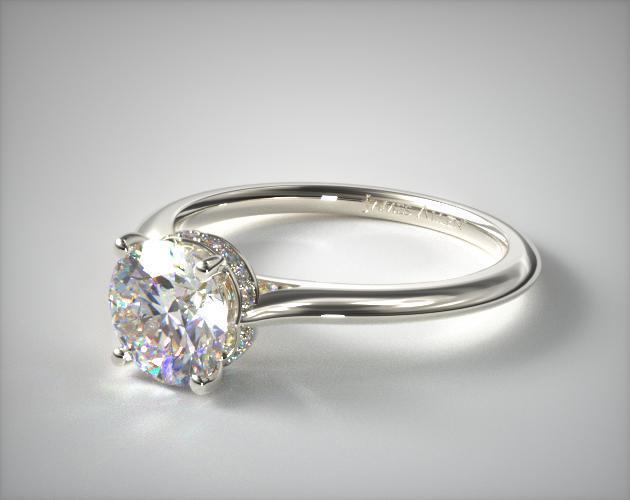
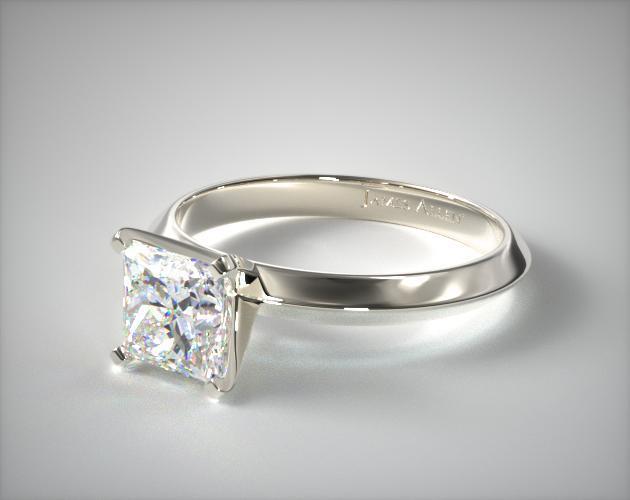
- Halo Setting
Halo settings offer protection and extra sparkle for the diamond. They are an excellent choice for princess cuts as they provide an added layer of security for the diamond.
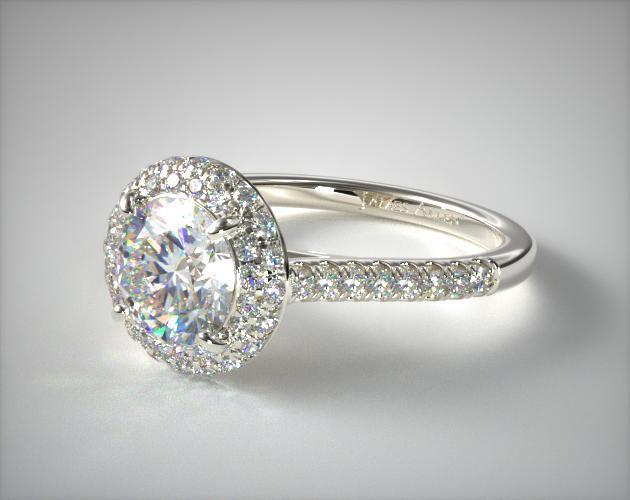
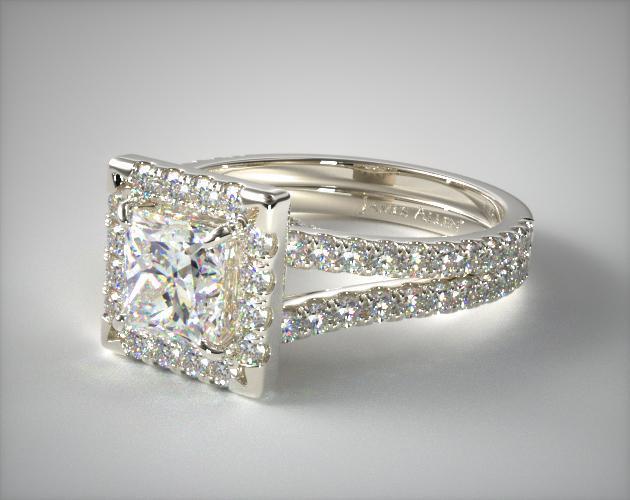
- Bezel Setting
Bezel settings offer the most protection for diamonds. These are perfect for princess cut stones but may minimize the sparkle and size of the diamond.
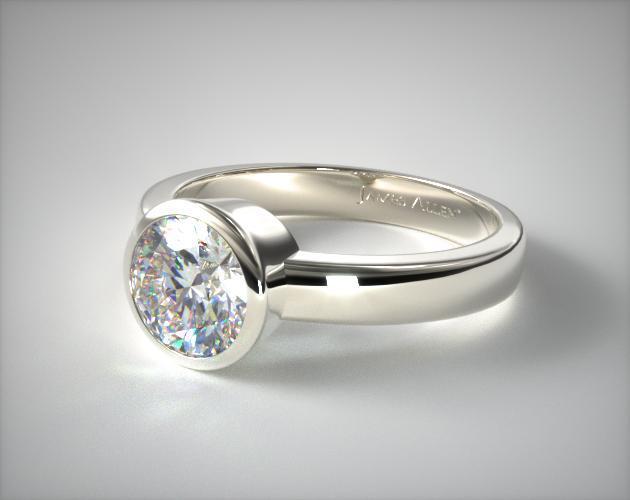
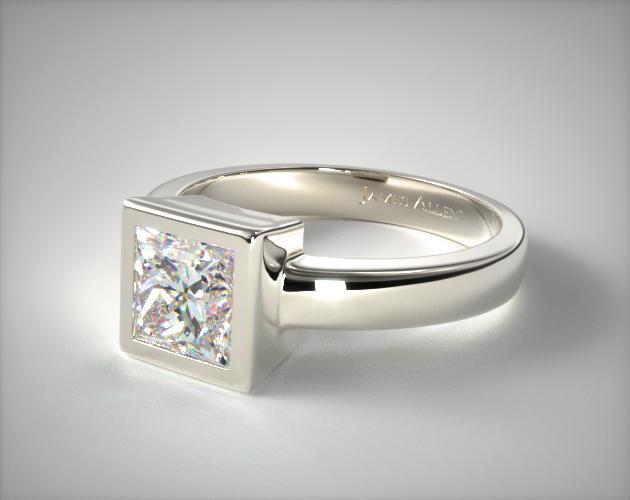
These are among the most popular engagement ring setting styles. But there are many options to choose from, including vintage designs, three-stone rings, and modern styles such as the tension ring setting.
Which Should I Choose?
Now that we’ve looked at the pros and cons of these two diamond cuts, let’s see which of these is the best for you. Truth be told, there’s no correct answer. The diamond cut you choose depends on your personal preference, budget, and lifestyle.
If you’re going for a classic, traditional look, that offers slightly more durability and brilliance, we recommend opting for the round diamond. However, be prepared to spend more on this shape.
For a more modern look, and an edge in terms of price, choose the princess cut. However, note that there is slightly less durability compared to a round diamond.
Where to Buy the Best Diamonds
If you’re purchasing your diamond online, it’s essential to choose from a reputable retailer with excellent after sales policies. We recommend the following retailers:
Why: Superior diamond imaging, competitive prices, high quality, wide range
An online giant in the diamond space, James Allen a stunning collection of high-quality round and princess diamonds. The images and videos are unparalleled in quality and makes shopping online similar, if not better, to shopping in store.
Why: Competitive prices, wide range, great quality
Known for dominating the online diamond industry since the late 1990s, Blue Nile offers one of the largest online diamond inventories. Search round and princess diamonds here at competitive prices, solid after-sales policies, and good customer service.
Why: Superior cut quality, exclusive range, stunning designs
Whiteflash has earned an international reputation for the elite quality of their precision cut diamonds, and for their impeccable collection of designer engagement rings. Check their stunning range of diamond jewelry and loose diamonds.
Why: Impeccable quality, superior cut, small but exclusive inventory
Brian Gavin is a renowned expert in diamond cut – and it shows in their superior diamond quality. For the very best in diamonds, search their inventory of designer diamond jewelry and loose diamonds.
Why: Try before you buy, build your own ring, great quality
If you want to try out how a round or princess diamond ring looks on your finger before you commit to buying one, check out With Clarity’s Home Preview Service which is completely free. Find out more here.
Wrapping Up
Choosing between the round and the princess cuts can be difficult, because both offer very competitive advantages. Regardless which you choose, you can’t go wrong with either of these cuts. No wonder they’re the most popular shapes and will be into the foreseeable future.









